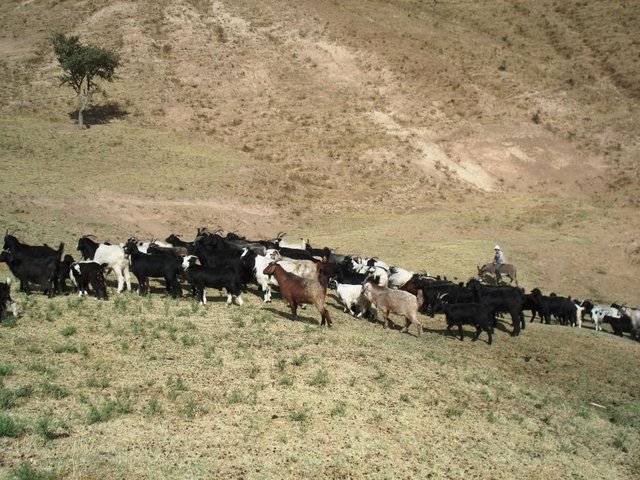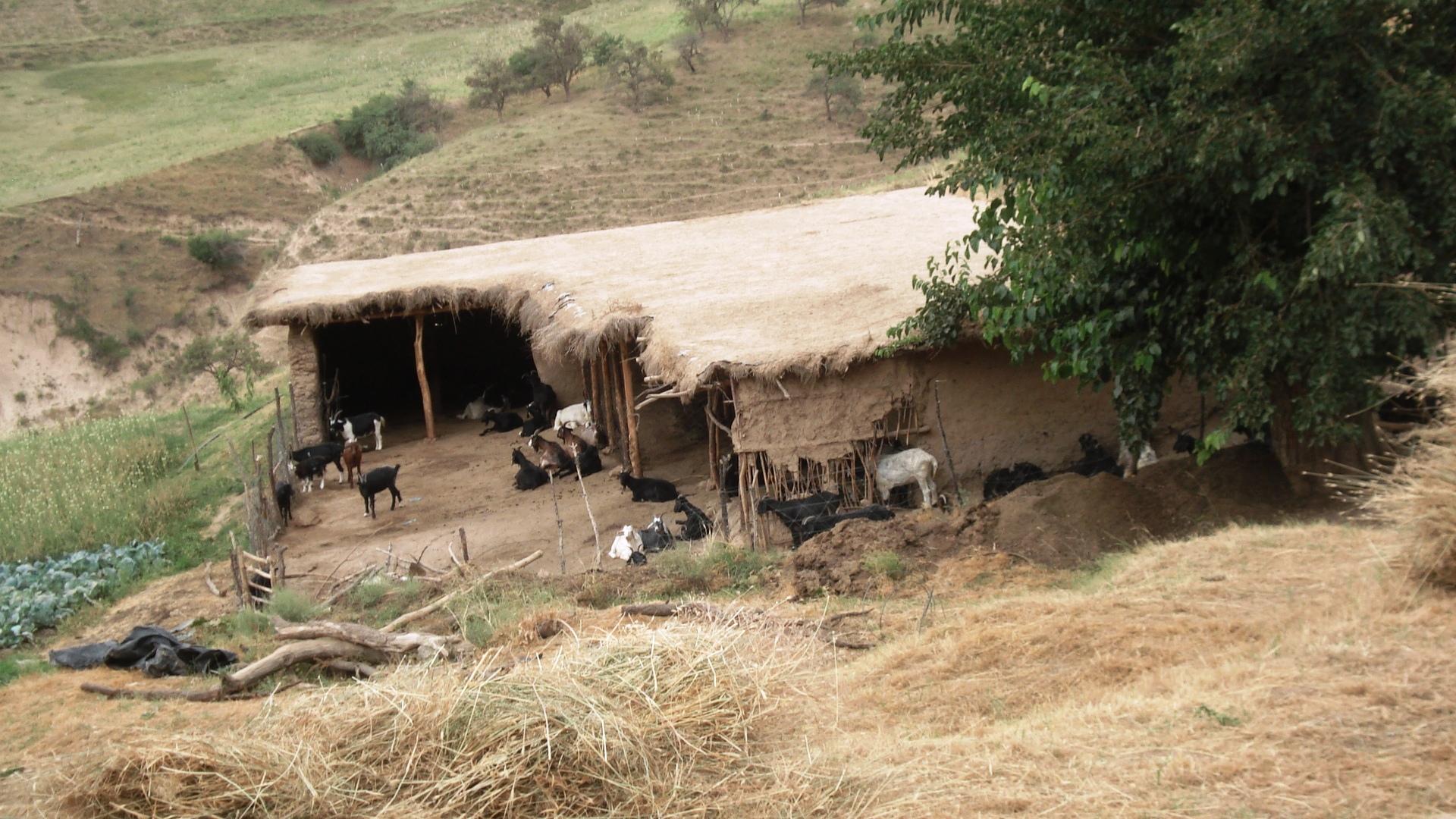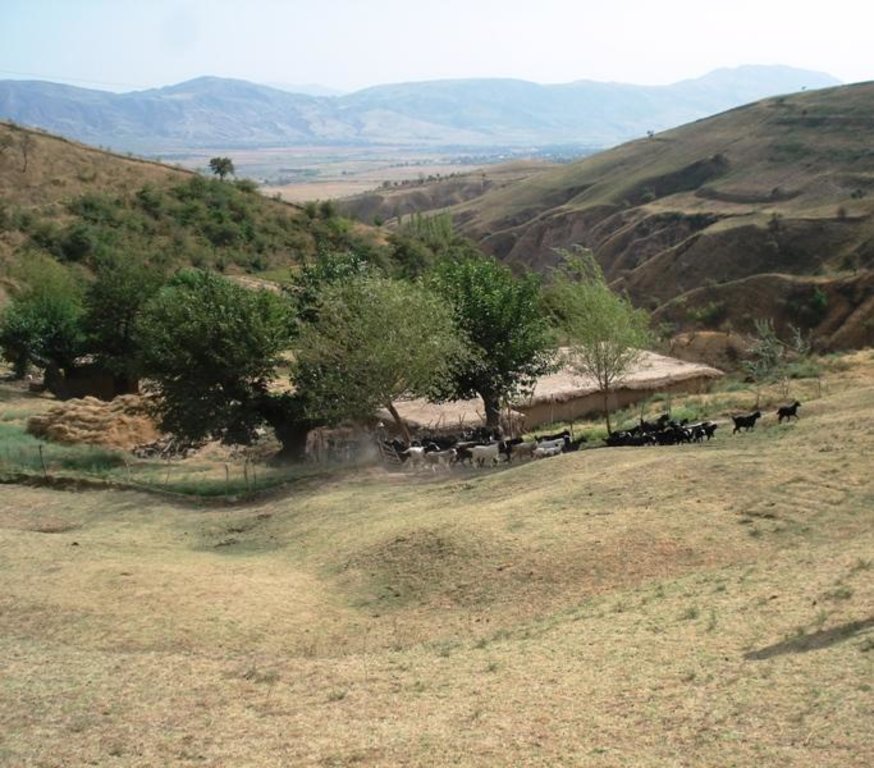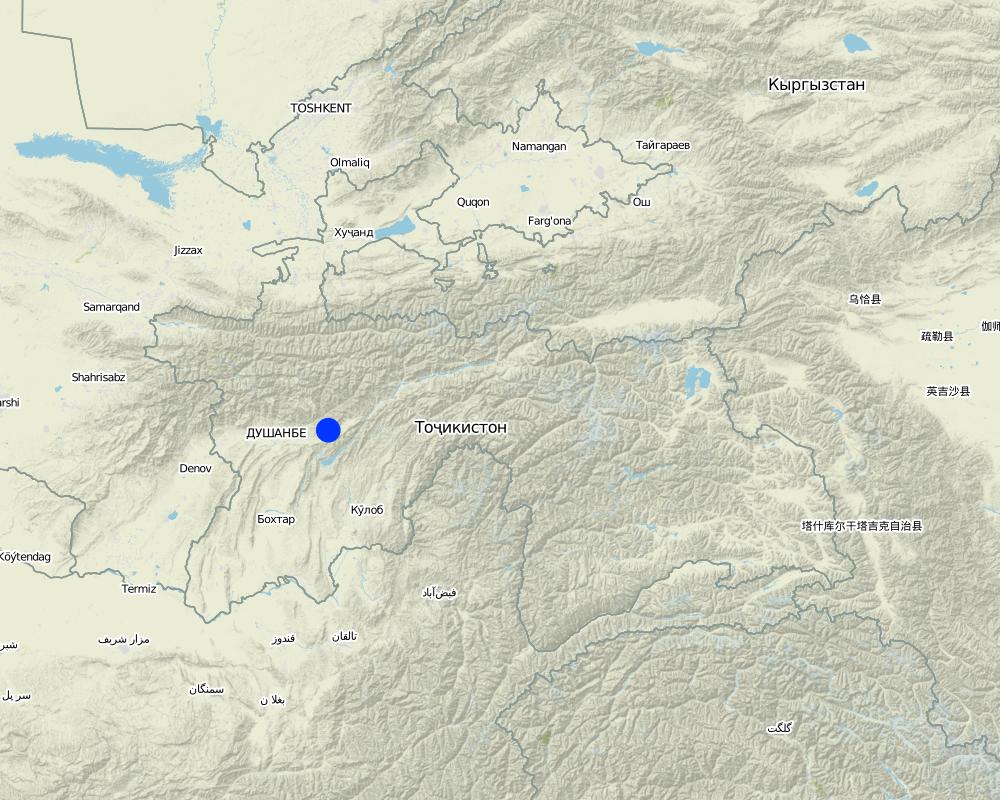Reduced livestock numbers [Tajikistan]
- Creation:
- Update:
- Compiler: Christian Wirz
- Editor: –
- Reviewers: Alexandra Gavilano, David Streiff
technologies_1343 - Tajikistan
View sections
Expand all Collapse all1. General information
1.2 Contact details of resource persons and institutions involved in the assessment and documentation of the Technology
land user:
Sahdullo
Karsang 1
Tajikistan
Name of the institution(s) which facilitated the documentation/ evaluation of the Technology (if relevant)
CDE Centre for Development and Environment (CDE Centre for Development and Environment) - SwitzerlandName of the institution(s) which facilitated the documentation/ evaluation of the Technology (if relevant)
NCCR North-South (NCCR North-South) - Kyrgyzstan1.3 Conditions regarding the use of data documented through WOCAT
The compiler and key resource person(s) accept the conditions regarding the use of data documented through WOCAT:
Yes
1.5 Reference to Questionnaire(s) on SLM Approaches (documented using WOCAT)

Family-based daily herding [Tajikistan]
Private herding of 50 goats by the land user and his sons.
- Compiler: Christian Wirz
2. Description of the SLM Technology
2.1 Short description of the Technology
Definition of the Technology:
The grasslands are used as pastures by a reduced number of livestock belonging to an individual land user.
2.2 Detailed description of the Technology
Description:
The around 50 goats are brought to the pastures early in the morning and will be brought back to their stable from 9 a.m. to 5 p.m. After this, they will be accompanied to the pastures again. In the morning the west-exposed and in the afternoon the east-exposed pastures are visited. The same rotational scheme is applied over the whole year, which means that the same pastures are visited daily. The pastures are exclusively used by the land user fror more than the half of the year (from autumn to spring). In summer the pastures are also used by the village herd of the nearby village (Karsang). Herding is mostly the task of the land user's sons but sometimes he will accompany the animals by himself. Cows are let out on the pastures in the morning and come back in the evening by themselves.
Purpose of the Technology: The reason for west-facing grazing in the morning and east-facing in the evening is that grass is moist at these times of day. This is also why at noontime animals are not on the pastures. The animals are led slowly by the herder as to not tire them, to make them fatter and to avoid damages on vegetation.
Establishment / maintenance activities and inputs: No special pasture maintenance activities are undertaken.
Natural / human environment: The area is around one hour away from the village which actually controls the pastures (communal pastures). In addition snow lies longer in spring than further down. This means that the village herd only comes here from late spring to late summer, which decreases the pressure on the pastures. Together with the situation in a small depression that protects from high radiation in summer this contributes to the generally better pasture quality (greener, more grasses) compared with the village pastures in proximity to the villages. An important factor contributing to the generally good conservation state are the reduced livestock numbers. They are only reduced because the land user is close to these more distant pastures and the village is quite far away.
2.3 Photos of the Technology
2.5 Country/ region/ locations where the Technology has been applied and which are covered by this assessment
Country:
Tajikistan
Region/ State/ Province:
Region of Republican Subordination
Further specification of location:
Faizabad
Specify the spread of the Technology:
- evenly spread over an area
If precise area is not known, indicate approximate area covered:
- 0.1-1 km2
Comments:
Total area covered by the SLM Technology is 0.5 km2.
Map
×2.6 Date of implementation
If precise year is not known, indicate approximate date:
- 10-50 years ago
2.7 Introduction of the Technology
Specify how the Technology was introduced:
- through land users' innovation
Comments (type of project, etc.):
The land user has rented land for the establishment of a self-sufficient agropastoral system after independence (early 1990ies). A part of the area was used as cropland when there was still a village (in the middle of the 20th century) whereas other parts of the land were also used as pastures.
3. Classification of the SLM Technology
3.1 Main purpose(s) of the Technology
- reduce, prevent, restore land degradation
3.2 Current land use type(s) where the Technology is applied

Grazing land
Extensive grazing:
- Ranching
Animal type:
- goats
- cows
Species:
goats
Count:
50
Comments:
Major land use problems (compiler’s opinion): Especially in the places where animals pass regularly and where they stay for longer times physical degradation of soils (compaction, crusting) together with the degradation of vegetation (cover and biomass) are major problems. In addition, low fertility is also a problem for vegetation growth.
Major land use problems (land users’ perception): Water erosion problems associated with wood chopping. And trees wood be very important for climate regulation.
Ranching: Goats, cows
3.4 Water supply
Water supply for the land on which the Technology is applied:
- rainfed
Comments:
Water supply: Also mixed rainfed - irrigated
3.5 SLM group to which the Technology belongs
- pastoralism and grazing land management
3.6 SLM measures comprising the Technology

management measures
- M2: Change of management/ intensity level
Comments:
Main measures: management measures
3.7 Main types of land degradation addressed by the Technology

soil erosion by water
- Wt: loss of topsoil/ surface erosion

physical soil deterioration
- Pk: slaking and crusting
- Pi: soil sealing

biological degradation
- Bc: reduction of vegetation cover
- Bs: quality and species composition/ diversity decline
Comments:
Main type of degradation addressed: Wt: loss of topsoil / surface erosion
Secondary types of degradation addressed: Pk: sealing and crusting, Bc: reduction of vegetation cover, Bs: quality and species composition /diversity decline
Main causes of degradation: overgrazing (Big herds passing daily), other human induced causes (specify) (Inappropriate soils used for grazing), education, access to knowledge and support services, governance / institutional (Incapacity of government to implement soil conservation.)
3.8 Prevention, reduction, or restoration of land degradation
Specify the goal of the Technology with regard to land degradation:
- prevent land degradation
- reduce land degradation
Comments:
Main goals: prevention of land degradation, mitigation / reduction of land degradation
4. Technical specifications, implementation activities, inputs, and costs
4.1 Technical drawing of the Technology
Technical specifications (related to technical drawing):
Daily rotation on pastures of the village Karsang.
Location: Above Naobad. Faizabad / Tajikistan
Date: 25.08.09
Technical knowledge required for land users: moderate (The land user developed his own rotational scheme.)
Technical knowledge required for herders (sons and grandsons of land user): low (They just need to apply the scheme.)
Main technical functions: increase in nutrient availability (supply, recycling,…)
Secondary technical functions: control of dispersed runoff: impede / retard, increase in organic matter, improvement of water quality, buffering / filtering water, promotion of vegetation species and varieties (quality, eg palatable fodder)
Change of land use practices / intensity level: Reduced livestock numbers
Author:
Christian Wirz, Switzerland
4.2 General information regarding the calculation of inputs and costs
other/ national currency (specify):
Somoni
If relevant, indicate exchange rate from USD to local currency (e.g. 1 USD = 79.9 Brazilian Real): 1 USD =:
3.42
4.3 Establishment activities
| Activity | Timing (season) | |
|---|---|---|
| 1. | Buying livestock | Reduced livestock numbers |
4.4 Costs and inputs needed for establishment
| Specify input | Unit | Quantity | Costs per Unit | Total costs per input | % of costs borne by land users | |
|---|---|---|---|---|---|---|
| Other | Buying livestock | Goats | 50.0 | 87.7 | 4385.0 | 100.0 |
| Total costs for establishment of the Technology | 4385.0 | |||||
| Total costs for establishment of the Technology in USD | 1282.16 | |||||
4.5 Maintenance/ recurrent activities
| Activity | Timing/ frequency | |
|---|---|---|
| 1. | Herding | Daily |
| 2. | Giving salt to livestock | Twice per week |
| 3. | Fodder for livestock | In winter |
4.6 Costs and inputs needed for maintenance/ recurrent activities (per year)
| Specify input | Unit | Quantity | Costs per Unit | Total costs per input | % of costs borne by land users | |
|---|---|---|---|---|---|---|
| Labour | Herding daily | days | 365.0 | |||
| Other | Salt for animals | for one year | 1.0 | 12.0 | 12.0 | |
| Other | Fooder for livestock | winter | 1.0 | |||
| Total costs for maintenance of the Technology | 12.0 | |||||
| Total costs for maintenance of the Technology in USD | 3.51 | |||||
Comments:
The only effective costs mentioned by the land user is salt for animals. Other inputs - be it labour or winter forage - does not have to be paid, respectively bought.
4.7 Most important factors affecting the costs
Describe the most determinate factors affecting the costs:
Labour input is decisive: As long as work is done by family members costs are restricted on alimentation. If external labour is hired, wages have to be added.
5. Natural and human environment
5.1 Climate
Annual rainfall
- < 250 mm
- 251-500 mm
- 501-750 mm
- 751-1,000 mm
- 1,001-1,500 mm
- 1,501-2,000 mm
- 2,001-3,000 mm
- 3,001-4,000 mm
- > 4,000 mm
Agro-climatic zone
- semi-arid
Thermal climate class: subtropics
5.2 Topography
Slopes on average:
- flat (0-2%)
- gentle (3-5%)
- moderate (6-10%)
- rolling (11-15%)
- hilly (16-30%)
- steep (31-60%)
- very steep (>60%)
Landforms:
- plateau/plains
- ridges
- mountain slopes
- hill slopes
- footslopes
- valley floors
Altitudinal zone:
- 0-100 m a.s.l.
- 101-500 m a.s.l.
- 501-1,000 m a.s.l.
- 1,001-1,500 m a.s.l.
- 1,501-2,000 m a.s.l.
- 2,001-2,500 m a.s.l.
- 2,501-3,000 m a.s.l.
- 3,001-4,000 m a.s.l.
- > 4,000 m a.s.l.
5.3 Soils
Soil depth on average:
- very shallow (0-20 cm)
- shallow (21-50 cm)
- moderately deep (51-80 cm)
- deep (81-120 cm)
- very deep (> 120 cm)
Soil texture (topsoil):
- medium (loamy, silty)
Topsoil organic matter:
- medium (1-3%)
- low (<1%)
If available, attach full soil description or specify the available information, e.g. soil type, soil PH/ acidity, Cation Exchange Capacity, nitrogen, salinity etc.
Soil fertility: Mainly medium, but also low
Soil water storage capacity: low - medium
5.4 Water availability and quality
Ground water table:
> 50 m
Water quality (untreated):
good drinking water
Comments and further specifications on water quality and quantity:
Ground water table: Mostly no groundwater, since very hilly.
Water quality (untreated): Good source water, since no diarrhae after drinking it.
5.5 Biodiversity
Species diversity:
- high
Comments and further specifications on biodiversity:
Many medical plants
5.6 Characteristics of land users applying the Technology
Off-farm income:
- less than 10% of all income
Relative level of wealth:
- rich
Individuals or groups:
- individual/ household
Gender:
- men
Indicate other relevant characteristics of the land users:
Land users applying the Technology are mainly Leaders / privileged
Difference in the involvement of women and men: Women are implied in housework, whereas men are working as herders, because of traditions.
Population density: < 10 persons/km2
Annual population growth: 1% - 2%
Off-farm income specification: The land user only depends on the rented land, cultivated together with his two sons and their families.
5.7 Average area of land used by land users applying the Technology
- < 0.5 ha
- 0.5-1 ha
- 1-2 ha
- 2-5 ha
- 5-15 ha
- 15-50 ha
- 50-100 ha
- 100-500 ha
- 500-1,000 ha
- 1,000-10,000 ha
- > 10,000 ha
Is this considered small-, medium- or large-scale (referring to local context)?
- medium-scale
Comments:
The household has much more grazing land than average village households.
5.8 Land ownership, land use rights, and water use rights
Land ownership:
- state
Land use rights:
- open access (unorganized)
- communal (organized)
Water use rights:
- individual
Comments:
Pastures are in theory used by village communities, but enforcement of rotational grazing in remote ares is difficult. These pastures are therefore something between communal and open access pastures. The water is used by the land user without any restrictions.
5.9 Access to services and infrastructure
health:
- poor
- moderate
- good
education:
- poor
- moderate
- good
technical assistance:
- poor
- moderate
- good
employment (e.g. off-farm):
- poor
- moderate
- good
markets:
- poor
- moderate
- good
energy:
- poor
- moderate
- good
roads and transport:
- poor
- moderate
- good
drinking water and sanitation:
- poor
- moderate
- good
financial services:
- poor
- moderate
- good
6. Impacts and concluding statements
6.1 On-site impacts the Technology has shown
Socio-economic impacts
Production
fodder quality
animal production
Income and costs
farm income
Comments/ specify:
His animals yield higher prices on the market than average livestock.
economic disparities
Comments/ specify:
The productive success of the land user lets him appear richer than the rest of the village.
Socio-cultural impacts
food security/ self-sufficiency
Comments/ specify:
Having a big herd on a big pasture area is a guarantee for better self-sufficiency.
conflict mitigation
Comments/ specify:
Especially in the establishment phase there was jealousy about the success, especially in fruit-production.
Livelihood and human well-being
Ecological impacts
Soil
soil cover
Comments/ specify:
Especially biomass is reduced by daily grazing.
soil loss
soil crusting/ sealing
Biodiversity: vegetation, animals
plant diversity
Comments/ specify:
Especially the proportion of grasses is higher compared with other village pastures
6.3 Exposure and sensitivity of the Technology to gradual climate change and climate-related extremes/ disasters (as perceived by land users)
Gradual climate change
Gradual climate change
| Season | increase or decrease | How does the Technology cope with it? | |
|---|---|---|---|
| annual temperature | increase | not well |
Climate-related extremes (disasters)
Climatological disasters
| How does the Technology cope with it? | |
|---|---|
| drought | not well |
6.4 Cost-benefit analysis
How do the benefits compare with the establishment costs (from land users’ perspective)?
Short-term returns:
very positive
Long-term returns:
very positive
How do the benefits compare with the maintenance/ recurrent costs (from land users' perspective)?
Short-term returns:
very positive
Long-term returns:
positive
Comments:
On the long term benefits of animal husbandry might be slightly reduced due to damages on vegetation (and soils) by the own and by the animals of the village herd.
6.5 Adoption of the Technology
- single cases/ experimental
Of all those who have adopted the Technology, how many did so spontaneously, i.e. without receiving any material incentives/ payments?
- 91-100%
Comments:
Comments on acceptance with external material support: The only land user with this form of management known is the one interviewsd
100% of land user families have adopted the Technology without any external material support
There is no trend towards spontaneous adoption of the Technology
Comments on adoption trend: This form of management combines an exceptional personal spirit of innovation and financial means to lease land as to establish a self-sufficient system in the hills. It is also necessary to have a truck and / or car to transport goods to the market and to stay in touch with the rest of the family in the village, since it is too small to offer space to all the household members.
6.7 Strengths/ advantages/ opportunities of the Technology
| Strengths/ advantages/ opportunities in the land user’s view |
|---|
|
Self-sufficiency is the main success for him. How can they be sustained / enhanced? It requires high labour inputs and motivation, which for the land user are necessary to have success in the post-USSR setting. |
| The animals yield a higher price because they are fatter than the other animals. |
| The geographic location is clearly an advantage, because the land user is far away from the negative impact of village herds. |
| Strengths/ advantages/ opportunities in the compiler’s or other key resource person’s view |
|---|
|
At the same time quite positive for soil and water conservation and productive in terms of meat and sold livestock. How can they be sustained / enhanced? If the land user could rent (parts of the) pastures the interest of planting trees as a measure of rehabilitation would increase. |
6.8 Weaknesses/ disadvantages/ risks of the Technology and ways of overcoming them
| Weaknesses/ disadvantages/ risks in the land user’s view | How can they be overcome? |
|---|---|
| Trees cannot recover because of constant grazing. | Only if the land user is sure that investments will profit him, that is if land tenure is clarified, will he invest into active conservation measures. |
| Weaknesses/ disadvantages/ risks in the compiler’s or other key resource person’s view | How can they be overcome? |
|---|---|
| Especially at the crossing-points of the land user's herd with the village herd degradation phenomena (trampling paths) are visible. | By an agreement between the village (land commitee) and the land user the land use could be reglemented clearer. |
| This form of land use is difficult to maintain for young people who want to participate in social life. And it is not sustainable because it does not permit allvillagers to practice such forms of herding that require much land. | The land user should be able to rent a part of the pastures (smaller than the actually grazed 50 ha) where he would be need to conserve soils and vegetation (for instance. by tree-planting or more sophisticated rotation. |
7. References and links
7.1 Methods/ sources of information
Links and modules
Expand all Collapse allLinks

Family-based daily herding [Tajikistan]
Private herding of 50 goats by the land user and his sons.
- Compiler: Christian Wirz
Modules
No modules






